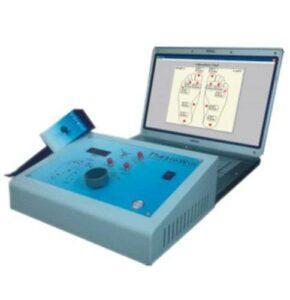Are you interested in learning about the latest advancements in medical evaluations for sensory abnormalities? Look no further than Vibratory Perception Threshold (VPT) Analysis Systems. These systems utilise vibration stimulation to measure sensory thresholds and aid in diagnosing neurological disorders and other sensory impairments. In this blog, we will explore the different techniques and tools used in VPT Analysis Systems, the role of these systems in diagnostic evaluations, and the components utilised in capturing and measuring sensory responses.
Understanding Vibratory Perception Threshold Analysis
Vibratory Perception Threshold (VPT) Analysis Systems are a non-invasive technique used to evaluate sensory abnormalities. They involve the application of vibration to specific areas of the body to measure the threshold of sensory perception. VPT Analysis is used to diagnose a range of sensory impairments, including peripheral neuropathy, carpal tunnel syndrome, and other neurological disorders.
Discover Different Techniques and Tools Used in Threshold Analysis
VPT Analysis Systems utilise vibration stimulation to measure sensory thresholds. They are one of several techniques used in threshold analysis, including thermal, electrical, and pressure stimulation. However, VPT Analysis is considered the gold standard for measuring sensory thresholds due to its high sensitivity and specificity.
Types Of Vibratory Perception Threshold (VPT) Analysis Systems
There are several types of Vibratory Perception Threshold (VPT) tests that can be used to assess sensory perception and thresholds. These tests are designed to evaluate an individual’s ability to detect and perceive vibrations. Here are some common types of VPT tests:
Vibration Perception Threshold Test (VPTT)
This is the most widely used VPT test and involves applying vibratory stimuli to specific sites on the body, such as the fingertips or toes. The individual indicates when they first feel the vibration, and the intensity of the vibration is gradually increased until it is clearly perceived. The VPTT helps assess the lower limits of vibration detection.
Vibration Intensity Difference Threshold Test (VIDT)
VIDT test measures an individual’s ability to detect differences in vibration intensity. Two vibratory stimuli of slightly different intensities are applied, and the person is asked to identify which stimulus feels stronger. The VIDT provides information about an individual’s ability to discriminate between different levels of vibration.
Frequency Difference Limen (FDL) Test
FDL test assesses an individual’s ability to perceive differences in vibration frequency. Two vibratory stimuli with slightly different frequencies are applied, and the person identifies which stimulus feels different. The FDL test helps evaluate frequency discrimination thresholds.
Amplitude Difference Limen (ADL) Test
ADL test measures an individual’s ability to perceive differences in vibration amplitude. Two vibratory stimuli with slightly different amplitudes are applied, and the person identifies which stimulus feels different. The ADL test evaluates amplitude discrimination thresholds.
Two-Point Discrimination Test
Although not strictly a VPT test, the two-point discrimination test can be used in conjunction with VPT analysis to assess tactile acuity. This test measures the minimum distance at which two distinct points of contact can be perceived as separate. It provides information about an individual’s ability to discriminate between two tactile stimuli.
Enhancing Diagnostic Evaluations with VPT Analysis
VPT Analysis Systems play a crucial role in diagnostic evaluations for sensory abnormalities. They are used to assess the severity of sensory impairments, monitor disease progression, and evaluate treatment efficacy. VPT Analysis is particularly useful in diagnosing neurological disorders such as diabetic neuropathy, multiple sclerosis, and Parkinson’s disease.
Explore the Role of VPT Analysis Systems in Measuring Sensory Thresholds for Diagnostic Purposes
VPT Analysis Systems are an essential tool in measuring sensory thresholds for diagnostic purposes. They provide objective measurements of sensory perception and aid in the diagnosis of sensory abnormalities. This Analysis is used in conjunction with other diagnostic evaluations, such as nerve conduction studies and electromyography, to provide a comprehensive assessment of sensory impairments.
VPT Analysis in Assessing Neurological Disorders
VPT Analysis Systems aid in evaluating sensory impairments associated with peripheral neuropathy, carpal tunnel syndrome, and other neurological disorders. They provide objective measurements of sensory thresholds and assist in diagnosing the severity of sensory abnormalities. VPT Analysis is also used to monitor disease progression and evaluate treatment efficacy.
Understanding Vibration Stimulation in VPT Analysis
Vibration stimulation is a critical component of VPT Analysis Systems. It involves the application of vibration to specific areas of the body to measure sensory thresholds. Vibration stimulation is used because it provides a non-invasive and painless method of measuring sensory perception.
Discover the Latest Developments in Data Acquisition Techniques Used in VPT Analysis Systems
VPT Analysis Systems utilise advanced data acquisition techniques to capture and measure sensory responses. These techniques include high-speed data acquisition, signal processing, and data analysis. The latest developments in data acquisition techniques have improved the accuracy and reliability of VPT Analysis Systems.
Exploring VPT Analysis System Components
VPT Analysis Systems consist of several components, including transducers, amplifiers, and signal processors. Transducers are used to apply vibration to specific areas of the body, while amplifiers and signal processors capture and measure sensory responses. The accuracy and reliability of VPT Analysis Systems depend on the quality and performance of these components.
Advantages of VPT
Vibratory Perception Threshold (VPT) Analysis Systems offer numerous advantages in the field of sensory evaluation and diagnostic assessments.
Accurate Sensory Evaluation
VPT Analysis Systems provide precise measurements of an individual’s sensory perception thresholds. By applying controlled vibratory stimuli and recording the responses, these systems offer objective and quantitative data regarding an individual’s ability to perceive vibrations. This accuracy aids healthcare professionals in diagnosing sensory impairments and monitoring changes over time.
Early Detection of Sensory Abnormalities
VPT Analysis Systems enable early detection of sensory abnormalities and peripheral neuropathy. By assessing the Vibratory Perception Threshold, healthcare providers can identify subtle changes in sensory function before they become clinically apparent. Early detection allows for timely interventions and improved treatment outcomes.
Objective and Standardised Assessments
VPT Analysis Systems provide quantitative measurements of sensory impairments. Instead of relying solely on subjective descriptions from patients, healthcare providers can now quantify sensory deficits and track their progression over time. This quantification aids in treatment planning, assessing treatment effectiveness, and determining the need for adjustments in therapeutic interventions.
Enhanced Diagnostic Capabilities
VPT Analysis is a non-invasive procedure that is well-tolerated by patients. The application of vibratory stimuli is painless and does not require any invasive procedures. This patient-friendly approach increases acceptance and compliance, allowing for widespread usage across different age groups and populations.
Tracking Treatment Progress
VPT Analysis Systems contribute to ongoing research and development in the field of sensory evaluation and neurological disorders. By providing standardised and reliable measurements, these systems facilitate data collection and analysis, leading to a better understanding of sensory abnormalities and their underlying mechanisms. This knowledge supports the development of innovative treatment modalities and advancements in the field.
VPTs from Leading Manufacturers
ThesioWIN
 ThesioWIN, manufactured by Recorders & Medicare Systems Pvt. Ltd. (RMS India), is an innovative and user-friendly digital threshold analysis system. Designed for both standalone and PC mode usage, ThesioWIN offers advanced features to aid in the early detection and accurate assessment of sensation loss caused by neuropathy.
ThesioWIN, manufactured by Recorders & Medicare Systems Pvt. Ltd. (RMS India), is an innovative and user-friendly digital threshold analysis system. Designed for both standalone and PC mode usage, ThesioWIN offers advanced features to aid in the early detection and accurate assessment of sensation loss caused by neuropathy.
Neuropathy-related injuries to the feet can often be painless, leading to chronic ulcerations and severe complications that may require amputations. However, with ThesioWIN, healthcare professionals can now identify and monitor sensation loss promptly, significantly reducing the risk of amputations.
ThesioWIN is equipped with a range of features that make it a valuable tool in the fight against neuropathy-related complications. When used in PC mode, it provides a tabular trend of Vibratory Perception Threshold (VPT), allowing for a comprehensive overview of the patient’s sensory perception over time. This trend analysis is crucial in quantifying sensation loss risk and enables healthcare providers to track progress and make informed decisions.
One standout feature of ThesioWIN is its sophisticated vibration mechanism, which virtually eliminates the possibility of pressure dependency of VPT measurements. This ensures accurate and reliable results, allowing for precise assessment of sensory thresholds without the interference of external factors.
With its PC-based functionality, ThesioWIN offers the convenience of generating printouts and detailed interpretations of the VPT data. This enables healthcare professionals to document and analyze the results efficiently, facilitating better communication with patients and enhancing the overall quality of care.
ThesioWIN’s versatility makes it suitable for a wide range of clinical settings, including hospitals, specialized clinics, and research facilities. Its user-friendly interface and intuitive design make it easy to operate, even for healthcare professionals who are new to threshold analysis systems.
Conclusion
In conclusion, Vibratory Perception Threshold (VPT) Analysis Systems offer advantages such as accurate sensory evaluation, early detection of abnormalities, objective assessments, quantification of impairments, enhanced diagnostics, non-invasiveness, treatment progress tracking, and contributions to research and development. These systems play a crucial role in improving patient care, facilitating early interventions, and advancing our understanding of sensory function and neurological disorders.
Medzell, a futuristic B2B platform, promotes medical devices in emerging markets. Medzell offers a wide range of medical devices, including VPT Analysis Systems, to provide access to affordable and high-quality medical devices in emerging markets. With Medzell, medical professionals can access the latest advancements in medical technology to provide better patient care.


